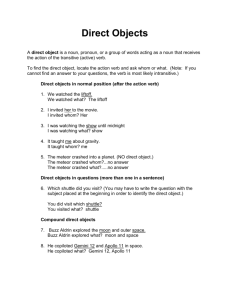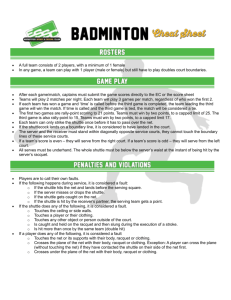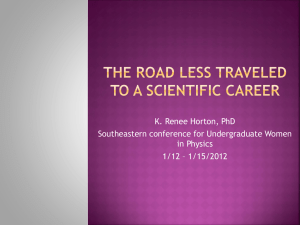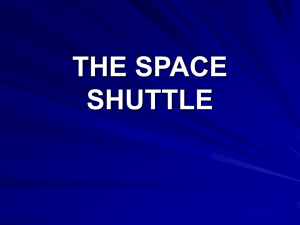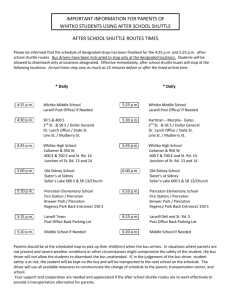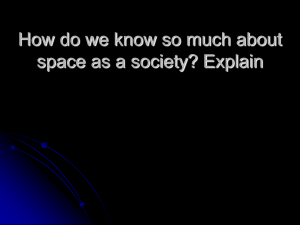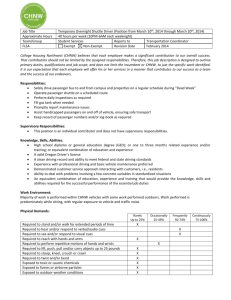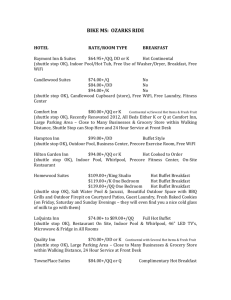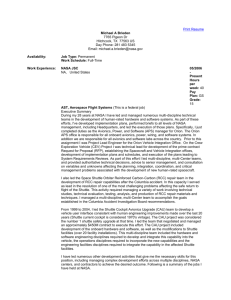REMARKS FOR ADMINISTRATOR BOLDEN AIAA NEW HORIZONS
advertisement
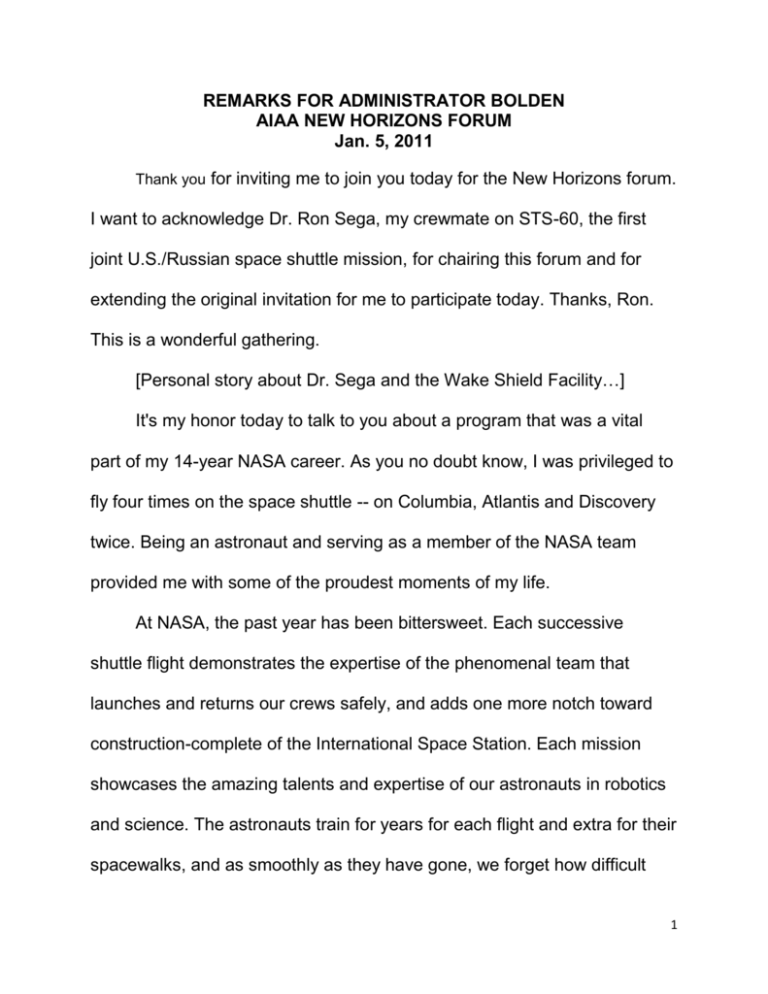
REMARKS FOR ADMINISTRATOR BOLDEN AIAA NEW HORIZONS FORUM Jan. 5, 2011 Thank you for inviting me to join you today for the New Horizons forum. I want to acknowledge Dr. Ron Sega, my crewmate on STS-60, the first joint U.S./Russian space shuttle mission, for chairing this forum and for extending the original invitation for me to participate today. Thanks, Ron. This is a wonderful gathering. [Personal story about Dr. Sega and the Wake Shield Facility…] It's my honor today to talk to you about a program that was a vital part of my 14-year NASA career. As you no doubt know, I was privileged to fly four times on the space shuttle -- on Columbia, Atlantis and Discovery twice. Being an astronaut and serving as a member of the NASA team provided me with some of the proudest moments of my life. At NASA, the past year has been bittersweet. Each successive shuttle flight demonstrates the expertise of the phenomenal team that launches and returns our crews safely, and adds one more notch toward construction-complete of the International Space Station. Each mission showcases the amazing talents and expertise of our astronauts in robotics and science. The astronauts train for years for each flight and extra for their spacewalks, and as smoothly as they have gone, we forget how difficult 1 they are. So it is impossible not to feel a little sadness that each flight brings us closer to the final voyage of one of our flagship programs, and the final chapter in one of the most storied eras in the history of human spaceflight. At the same time, we stand ready to vigorously launch the exciting new direction we've been given through a strongly bi-partisan Authorization Act. The shuttle has provided this nation with many firsts, with many proud moments, and it has helped the United States to lead the world in space exploration. I was fortunate enough to be part of two of its historic achievements: that first U.S./Russian shuttle mission, STS-60, that Ron and I flew together -- which presaged the unprecedented international cooperation we've achieved since on the International Space Station -- and the deployment on STS-31 of the Hubble Space Telescope, which has redefined our perception of the universe; rewritten textbooks; and inspired a whole new generation of scientists and technology developers. So, yes, we are understandably proud of the shuttle. It has served our nation and the world well. And while we naturally feel some sadness about the end of this program that has been operational now for 30 years, a bit like saying goodbye to an old friend, as I said, we are also thrilled to be on the cusp of a whole new era of exploration capabilities. 2 This generational change we're going through at NASA comes during a year of space milestones. We're approaching the 50th anniversary of Yuri Gagarin becoming the first human in space on April 12th; the same day we celebrate the 30th anniversary of the first shuttle mission, STS-1. I know Bob Crippen, pilot of that mission, moderated a panel here yesterday. Since STS-1, 360 individuals in total have flown on this amazing machine. Let me remind you that Bob's flight with John Young on STS-1 was still the only time in history that astronauts were aboard a spacecraft on its actual first test flight into space. I know yesterday's panel talked about the early days of the program, so I won't go over the tens of thousands of wind tunnel tests, or Marshall's vibration testing, or the endless refining of the designs for this vehicle that was largely theoretical up until it finally blasted off the pad in April 1981. The shuttle is still an experimental vehicle in the purest sense. Even though we know many things about it and we are confident in our procedures and its systems, it is still very much a vehicle that continues to teach us, that we continue to refine, and from which we will apply many lessons learned to our next space systems. 3 We have learned technologically, operationally, and on a very human level from this program. For instance, while the outer mold line of the shuttle has not fundamentally changed since that first flight, constant improvements in technology have been incorporated throughout the program's life. Any future system will have to do the same – incorporating changes and upgrades as we fly and learn and apply new data to improve safety and make ever more challenging missions possible. To name just a few of the upgrades we've made on the orbiter as we went along: We improved the vehicle's thermal protection system, toughened the tiles, and replaced them in many areas with more durable and less expensive blankets. We upgraded the cockpit displays and hardware to make them lighter in weight and easier to read for pilots. We developed GPS landing aids that help pilots pinpoint their runway target and angle of descent. We created an orbiter boom sensor system that can sweep the shuttle and inspect its protective skin for damage that can occur not only during launch, but also from orbital debris. 4 We've also made improvements over the life of the program to our propulsion systems: the reusable solid rocket motors, the solid rocket boosters, and the space shuttle main engines: - Updates to the field, factory, and nozzle/case joints made after the Challenger tragedy improved reliability and safety of the RSRMs and SRBs. - Continual process improvement and production upgrades have reduced RSRM costs significantly - The main engines were the first reusable liquid booster engines designed for human spaceflight and have seen a number of upgrades. We went from Block I to the current Block II standard to optimize performance for the heavy payloads that would be required for ISS construction. - The Advanced Health Monitoring System makes the SSMEs safer and works to autonomously detect and annunciate anomalies and even shut down an engine if required. We've also improved the shuttle's external tank. Its original weight has decreased by over 18,000 pounds in the latest generation of superlightweight tank. After the Columbia tragedy, we improved our foam application processes, removed the protuberance air load ramp from the tank, and 5 developed analytical models to help identify critical foam loss areas on the tank. This allowed the teams to focus foam application design changes on these critical areas. Ascent imagery was also greatly improved and this allowed the teams to insure that the tank design changes were having the desired effects. The shuttle was built to accomplish a wide variety of different types of missions. In those early days we deployed numerous satellites for paying customers. These were scientific and defense satellites as well as commercial communications spacecraft, including communications satellites for many other countries. We retrieved them from space for repair. We demonstrated that humans could actually service a satellite in space. The Chandra X-ray Observatory that, among many other things, documented the largest supernova ever observed, was deployed from a shuttle. Many of the Tracking and Data Relay, or TDRS, satellites were launched from the shuttle. These satellites are not only used by NASA to maintain contact with the shuttles and the ISS, they also provide data services to the Hubble Space Telescope, and even the recent launch of the 6 Dragon space capsule on a Falcon 9 rocket used TDRSS for communication. One of the shuttle program's greatest achievements was the construction of the International Space Station – which simply would not have been possible otherwise. The station is an engineering marvel now coming into its own as a unique laboratory, and we are making plans for the next decade of its life. It's also a model of international cooperation that will serve us well in all our future global space enterprises. The next generation of space transportation systems will need to be as flexible as the shuttle has been, while improving safety, taking advantage of changes in technology, and reducing costs. Some operational lessons we learned from shuttle include: A streamlining of our orbiter processing, something that will be essential as we anticipate a ramping up of demand for launch services by many parties. Those satellite-servicing missions I mentioned required us to innovate in many ways, including development of special tools that didn't exist before. Shuttle-Mir docking taught us many things we would later apply to rendezvous and docking operations with the ISS. 7 We updated and improved our orbiter imaging and assessing capabilities, including the rendezvous pitch maneuver where the shuttle literally flips over so its belly can be viewed from the Station, and also developed the wing leading edge impact sensors, and the boom observation system that I earlier described. Going forward, exploration will need to take advantage of a wide variety of partnerships, both domestically and internationally, to be successful. We learned a lot working with international partners over the past decades. With the Europeans, for instance, in planning and conducting SpaceLab missions and setting up TAL sites for launch abort support. Spacelab expanded the shuttle's ability to conduct science on-orbit. It helped forge the model of a large international joint venture involving government, industry, and science with our European partners. And, it provided us with a versatile laboratory system several years before it would have been possible if we had to do it alone. SpaceLab also provided Europe with the systems development and management experience to move into the human space flight arena. The Canadians were invaluable partners on the remote manipulator system and OBSS. The Russians taught us a tremendous amount during the Shuttle/Mir years and beyond, and all the international partnerships on 8 ISS continue to be a learning experience, not only technically, but also culturally, as we become a space faring people on a global scale. In addition to the technical accomplishments, and the discoveries it helped make possible, the shuttle transformed the face of human spaceflight. Astronauts have become a diverse group in every way – from the core expertise we still draw from the military, to citizen scientists, teachers and specialists in many areas. The program has been integral to providing flight opportunities for women and minorities. We may have suffered somewhat from our own success. From making things look too easy. The loss of two crews shocked and saddened the world and made us realize with each accident how very hard the space enterprise is. How much astronauts put on the line to strap themselves to seven million pounds of thrust to escape the confines of Earth's gravity. Nevertheless, the public has gotten used to the routine of space launches to the idea that we can put a 100 ton vehicle into space, dock with a space station, clamber around the outside of that outpost, perform amazing robotic feats, and come back safely. As we move toward a true commercial capability for reaching low Earth orbit, it seems people are yearning even more for routine access to space – one of the unfilled promises of the original space transportation 9 system. With greater commercial access to LEO, we're going to open up an entirely new segment of the economy and with this will come new high tech jobs. I hope we can all agree – as a nation, we’re ready for that. We know we can do it; in part because of all that we have learned from shuttle, and the fact that we have flown more than 130 missions to space – more than any other NASA human spaceflight program. The NASA Authorization Act of 2010 has recognized the importance to ISS of flying one more shuttle flight in addition to the two remaining on the manifest. We have looked at the safety aspects of that flight, and we have determined that this additional flight is as safe as previous flights and has adequate crew rescue capability if needed. We are currently planning to fly this additional flight, STS-135 – as the FY 2011 budget process sorts itself out. Meanwhile, there are the two regularly manifested flights in preparation and we look forward to their accomplishments. STS-133 will include delivery of the first robotic crew member to the station – Robonaut 2 (R2) – which will begin a new era of human and robotic partnership, and STS-134 will deliver the Alpha Magnetic Spectrometer to the ISS. The AMS will help us understand the origin and structure of the universe. In the future, we've been directed to facilitate the success of the commercial sector to transport crew and cargo to low Earth orbit. To that 10 end, our COTS and CCDev programs remain healthy. As we implement the NASA Authorization Act of 2010, they will see even more activity. SpaceX has made history with the launch of the Dragon capsule aboard a Falcon 9, successfully orbiting the Earth, and retrieving it after intact re-entry. Orbital Sciences recently successfully test fired its AJ26 engine for the Taurus rocket. The CCDev participants are working hard on their own systems and related businesses to support commercial transportation, and round two of that program will bring even more innovative ideas. The Authorization Act also directs NASA to develop a Space Launch System, the heavy lift rocket that will carry us on the next generation of missions beyond LEO. The Authorization Act also puts us on the path to developing many new technologies that will benefit from our deep pool of knowledge from shuttle and help take us to the next level. Things like inspace propulsion systems, inflatable habitats, and in-orbit refueling. A lot of these technologies that will take us beyond low Earth orbit are being discussed at this conference as they have been for years. Thanks to President Obama signing the NASA Authorization Act of 2010 after its passage by overwhelming bipartisan vote of the Congress, we now have a roadmap that will help us make progress on these critically needed technologies. 11 I can proudly say that the shuttle has been a huge benefit to society. Each mission has accomplished many objectives – from the high profile satellite deployments, to flying experiments for recognized researchers and school children. It's helped us improve communications on Earth and to understand our home planet better. It's set scientific satellites speeding on their missions into the solar system. It's given us tremendous knowledge about a reusable spacecraft and launch system from which future commercial systems will benefit. It's enabled construction of the station. It's given us unprecedented views of our planet. We will never forget the sacrifices of our brave crews on Challenger and Columbia. Several were close personal friends whom I shall never forget. But we must also never forget the accomplishments, the joy, the knowledge and the pride this program has brought our country. Human spaceflight survived in great part because of the shuttle program, and we are in a good position today as a result to continue the innovations we started with shuttle and take them to the next level. The inspiration of those engineers in the 1960s as they first batted about the idea of a blunt-nosed, reusable space vehicle have soared beyond anyone's wildest expectations. It is with great pride that as NASA 12 Administrator, I will salute our remaining birds and their crews as they enter history and we stand on their shoulders to reach the future. Thank you. 13
